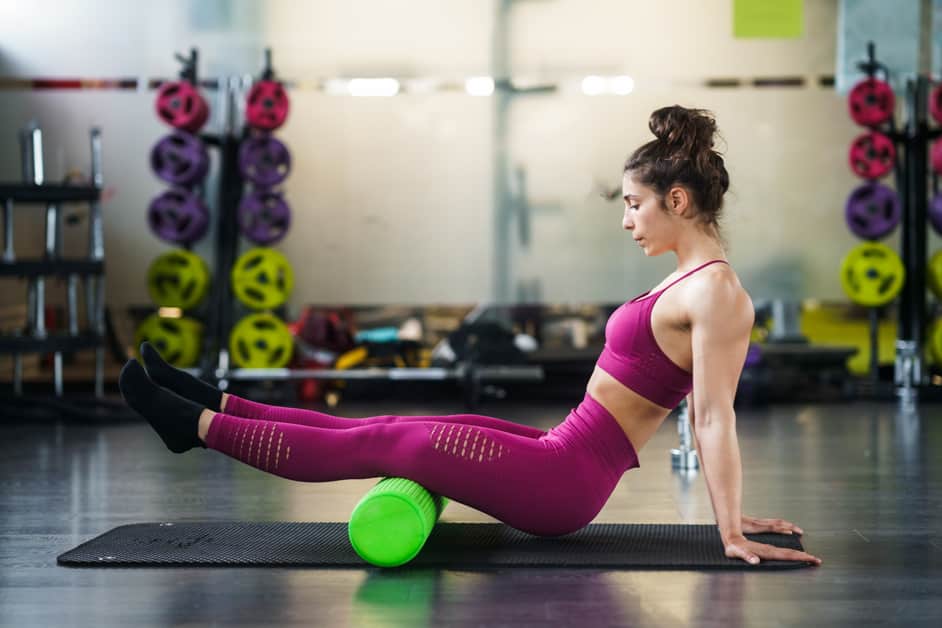Introduction
Foam rolling is great for knee stability and balance. It can also help ease stiffness or soreness. Regular use of foam rolling can help athletes of all ages keep their knees strong and healthy.
In this article, we’ll tell you the basics of foam rolling and which exercises you can do to strengthen your knees. We’ll also talk about foam rolling’s benefits for treating knee pain and other injuries. Lastly, we’ll provide tips on how to use foam rolling correctly for optimal results and to prevent further injury.
What is Foam Rolling?
Foam rolling is a type of self-myofascial release. It’s a great way to loosen tight muscles. It breaks up fascial adhesions and scar tissue that can happen from activity or injury.
The foam roller can be found in most fitness stores or online. It targets large muscle groups, like the quadriceps and hamstrings. To use it, move the muscles along the length of the roller. Apply gentle to moderate pressure. This helps increase range of motion and reduces pain.
Foam rolling has other benefits:
- It can improve posture and balance.
- It can reduce tension headaches and increase flexibility.
- It can improve circulation in the knees by increasing oxygenation.
- Plus, it can help you perform better in activities like running, biking, and jumping.
- It can improve nerve-to-muscle communication and increase joint mobility.
Benefits of Foam Rolling
Foam rolling is awesome! It can better your knee stability and balance. It even eases pain and enhances flexibility. It’s a self-myofascial release technique which stretches your leg muscles and tendons.
Let’s dive deeper into the perks of foam rolling:
Improved Mobility
Foam rolling has many health benefits! It can help improve your ability to do everyday tasks. Benefits include increased joint mobility, reduced tension, reduced inflammation, improved circulation, and breaking down scar tissue. This leads to increased joint flexibility with less pain.
Foam rolling also helps with knee stability and balance. It significantly boosts mobility in the patella and tibial. Plus, it increases knee flexion and decreases muscle stiffness overall. This means muscles can better absorb impact from walking or running, which helps protect joints and provide greater stability.
Foam rolling is great for improved performance during physical activities. Plus, it improves postural alignment for everyday tasks. Even better, it reduces pain and aches so you can recover and increase comfort during physical activity.
Improved Flexibility
Foam rolling is a great self-massage technique to boost flexibility. Rolling compresses your muscles, which reduces lactic acid buildup after exercise. The roller also relaxes and lengthens muscles, helping with spasms and contractures, as well as improving range of motion.
Studies show that regular foam rolling can increase joint range of motion by 10 degrees more than stretching alone. Plus, it increases soft tissue extensibility more than dynamic stretching. So, you’ll not only be more flexible, but you’ll also perform and balance better.
Improved Balance and Stability
Foam rolling is a great way to improve balance and stability for many activities. Studies in the Journal of Strength & Conditioning Research and the Journal of Sports Sciences show that foam rolling can increase knee stability and balance by increasing range of motion and decreasing muscle tension.
Benefits include improved mobility, posture, joint integrity, and muscular strength. It also reduces pain sensitivity of muscles due to overuse. Foam rolling keeps muscles in good shape and enables them to move without any restrictions, helping to protect against movement-related injuries.
Before any other exercises, it’s important to do self-myofascial release using a foam roller. This helps break down knots in the fascia (connective tissue) by applying pressure through the muscle fibers. Applying pressure through specific points along the roller while performing active stretching will also help mobilize tight muscles, as well as increase flexibility for more efficient use of muscles in physical activities.
How to Foam Roll
Foam rolling is a cinch and brings much advantage. It applies direct pressure to muscles and fascia – which lessens ache and boosts range of motion. Also, it can promote posture and balance through improved body awareness!
In this article, we’ll learn how to foam roll and all the great benefits that come with it:
Pre-Rolling Warm-Up
Before foam rolling, warm-up first. This helps with muscles and prepares them for the activity. The goal of foam rolling is to increase muscle activation, mobility and flexibility.
A dynamic warm-up is great for mobility and reducing the risk of injury. Examples are
- leg swings
- arm crosses
- side bends
- deep squats
- ankle circles
- and glute marches.
Foam rolling increases blood flow and nutrients to muscles. It also reduces soft tissue adhesions that limit range of motion. Rolling can be uncomfortable at first. However, it helps balance and stability when doing activities such as running or walking.
Roll slowly at four beats per inch. Give time for your body to adjust before moving to another point. Spend time on knotty areas. These require special techniques like staying longer or static stretching after rolling. Do not roll over joints as it causes unnecessary stress.
Foam Rolling Techniques
Foam rolling is a form of self-myofascial release. It helps with muscle and tissue pain, tightness, and inflammation. It can mobilize tissue, increase mobility, and help with joint health.
Two techniques should be used with foam roller myofascial release: direct pressure and energy curves.
- Direct pressure involves rolling over a specific area. Place the roller sideways over the calf or thigh, then roll back and forth slowly for 5-second intervals. This relaxes the muscles and increases circulation. Check with a doctor before attempting this if you have an injury or condition.
- Energy curves involve twisting your body around the length of the roller as you move it up or down. This hits different muscle groups. Use light pressure for best results, to make sure all tissues are relaxed without soreness or discomfort.
Post-Rolling Stretching
Post rolling stretching is must-have for foam rolling. After the foam roll, spend 5-10 minutes stretching the targeted muscles. This boosts mobility and flexibility – making foam rolling even more effective.
Static stretching should be done for 10-15 seconds. Go a step further and add dynamic warmup exercises such as squats and lunges. Focus on proper form when doing any exercise. Remember to engage your core muscles.
Spending a few extra minutes post foam rolling stretches ensures all muscles are given attention. This allows for better range of motion, flexibility, injury prevention, and improved performance.
Conclusion
Foam rolling can be a great help in managing knee pain and improving knee health. It reduces the risk of injury, increases strength, flexibility and balance. It also brings greater mobility, and improves range of motion around hips, ankles and feet. All this helps to support movements needed for strong knees.
To truly get maximum benefits from foam rolling, include it in your daily routine. Also, don’t forget to warm up prior to any activity and cool down afterwards. With proper technique, foam rolling will help you achieve better knee stability. So, don’t wait – start foam rolling today!
Frequently Asked Questions
Q: What are the benefits of foam rolling for knee stability and balance?
A: Foam rolling can help improve knee stability and balance by increasing flexibility in the muscles and connective tissues, reducing muscle soreness, improving joint range of motion, breaking up scar tissue, and improving blood circulation.
Q: How often should I foam roll?
A: Foam rolling should be done at least once a week, and more often if desired. It should be done slowly and gently, and the pressure should be adjusted to a comfortable level.
Q: Are there any safety concerns with foam rolling?
A: Foam rolling is generally safe, but it can cause pain in some cases. It is important to listen to your body and adjust the pressure accordingly. If you experience any pain or discomfort, stop immediately and consult your doctor.





